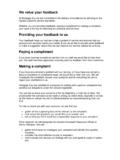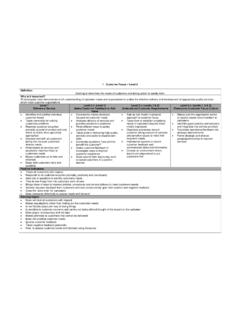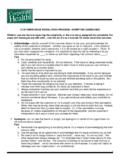Transcription of The journey toward greater customer centricity - United States
1 The journey toward greater customer centricityErnst & Young2 The journey toward greater customer centricity301 Executive summary 03 Introduction: evolving consumer dynamics Consumer demands and expectations Influencing persistency and retention Insurers are not meeting customers expectations05 Core principles for redefining customer relationships 07 Protecting the core: becoming more customer -focused customer -centric models Data for competitive advantage: advanced segmentation and data analytics Harnessing the power of digital as part of an integrated channel strategy15 customer -centric innovation A significant cultural shift Develop a culture of innovation16 Practical steps on the journey 19 Conclusion ContentsErnst & Young4 Advances in technology and communication, combined with the explosive growth in data and information, have given rise to a more empowered global journey toward greater customer centricity1 Executive summaryAdvances in technology and communication, combined with the explosive growth in data and information, have given rise to a more empowered global consumer.
2 Recent economic and political events highlight the need for insurers to understand how consumers view the world and the most important attributes for their purchasing decisions. Our discussions with global insurance executives, non-executive directors and regulators corroborate this view and demonstrate, without exception, that the challenge of responding effectively to rapidly changing consumer needs is one of the top strategic agenda items, alongside regulatory change and talent management. In our Ernst & Young Global Consumer Insurance Survey 2012 report, Voice of the customer ,1 we learned about the value of customer centricity and why it is so important to an insurer. Our survey probed customer attitudes and behaviors to determine how customers view and interact with the industry, as well as their expectations for the future. Our findings confirmed that those insurers who respond best to what customers want now are most likely to succeed. A clear understanding of customer needs and behaviors across the organization will help drive profitable growth strategies and provide the confidence to invest in opportunities at a time when staying within budget is extremely difficult.
3 In this paper, we explore how technology is changing consumer dynamics and show how insurers have an opportunity to influence persistency, retention and expectations through improved customer engagement. We discuss the strategic paradigm and operational areas where insurers can become more customer -focused: developing customer -centric models, applying advanced segmentation and data analytics to design an effective customer experience, harnessing the power of digital in an integrated channel strategy, and shifting to a new culture of innovation that will drive growth and competitive advantage. The journey to customer centricity will not be an easy endeavor. In building a strong foundation for the future, insurers will need to focus on a new set of core principles to redefine relationships. There will be many challenges in developing the critical new capabilities that align objectives, targets, rewards and recognition with customer needs. We offer practical steps for insurers to consider along the way as they build momentum for customer centricity across their organizations.
4 Some of the topics will be presented in greater detail in the months ahead. Look for a discussion of how insurers can harness digital more effectively in an upcoming 2013 this paper, we explore how technology is changing consumer dynamics and show how insurers have an opportunity to influence persistency, retention and expectations through improved customer Voice of the customer : time to rethink your relationships, Ernst & Young. Download at & Young2By 2020, it is anticipated there will be more than 50 billion connected devices globally, with mobile being the primary internet device for most journey toward greater customer centricity3 Introduction: evolving consumer dynamicsTechnology is growing at an exponential rate, influencing consumer behavior and insurance marketing strategies. By 2020, 80% of the global population will have access to mobile telephony and more than 60% to smartphones or low-cost tablet computers. It is anticipated there will be more than 50 billion connected devices globally, with mobile being the primary internet device for most individuals.
5 Social media and unprecedented access to information, such as peer-to-peer product and service reviews, are giving greater power to consumers, creating more informed and demanding customers. These experiences are shaping consumer expectations across all sectors, including insurance. Consumer demands and expectationsAlthough technology is changing the way customers engage with insurers, our survey indicates that personal interaction is still highly regarded. The complex nature of insurance products and customers need for advice mean that some level of personal interaction will remain an important component of overall channel strategy. Customers prefer products to be simpler and more transparent, so it is easier to make informed choices. This has implications for the role of insurance agents. In an industry where margins are coming under increasing pressure, insurers need to choose where they invest across the value chain to avoid adding extra cost while still paying agents for services c ustomers may prefer to do themselves.
6 These changes are forcing a dramatic change in the business operating model, as insurers need to focus on where their sales channels add value to the end customer . This will be helped by greater transparency in the sales process and in product , customers are looking for value to be clearly demonstrated, reflecting a balance of price, product features and service tailored to their needs. They prefer to buy more products from companies they trust. Once they have made their choice and established a relationship with an insurance provider, they expect the provider s products and services to meet their expectations and through their channel of choice. More demandingIncreased expectations: convenience, flexibility and personalization are a givenMore diverseGlobal growth of women in the workforceMore sophisticatedEmerging middle classes want more financial servicesMore hedonisticIt s all about meErnst & Young4 Influencing persistency and retentionRecognizing the value of the customer relationship is vital at the point of initial sale and over the customer lifetime.
7 customer segmentation models, which identify those who have the highest propensity to purchase, can improve customer satisfaction, compared to traditional unfocused product push cross-sell also have an opportunity to influence persistency and support retention through improved engagement with existing customers. This must be backed by flexibly designed products that respond to changing customer needs and financial incentives to reward customer loyalty over the customer life cycle rather than just at the point of lapse. But the key to improving persistency is removing the reasons why customers consider leaving in the first place. Use of predictive models can target customers based on likelihood of lapse and the value of retention, but test and learn approaches are essential to determine which interventions are most effective. Customers are willing to build long-term relationships with their providers and purchase multiple products. However, insurers must improve the effectiveness of their communications, as well as recognize and reward the value of the relationships.
8 Insurers are not meeting customers expectationsOur Voice of the customer survey indicates four dimensions where insurers are failing to meet customers expectations: service quality, rewarding loyalty, communication and product transparency. Consumers have a strong sense that insurers could do more to earn their trust. They tend to judge insurers against other consumer industries, expecting comparable standards of service and rewards for loyalty. Yet, in our client experience, insurers typically benchmark themselves against their peers in the industry. That s a big disconnect. Insurers need to continually evolve customer propositions to meet changing needs and expectations, particularly by improving information and transparency, and they need to look outside the industry to do this need for clarity and transparency is also driven by regulators protecting consumer interests more than ever before. Insurers that align themselves to a customer -centric model of operation will find the transition to the new regulatory environment less painful, and they may even gain a competitive are willing to build long-term relationships with their providers and purchase multiple products.
9 However, insurers must improve the effectiveness of their communications, as well as recognize and reward the value of the relationships. The journey toward greater customer centricity5In this fast-changing environment, insurers need to focus on a new set of core principles to redefine relationships with customers and transform business models. To achieve this new strategic paradigm and the first step on the journey to customer centricity insurers need to take the following business against disintermediation: Insurers unable to understand or deliver against current and future consumer needs and preferences face the prospect of losing the connection with or being pushed further away from the end customer . Insurers need to make sure they retain a strong influence on how customers view their products and services, regardless of overall channel strategy. Redefine customer relationships: Insurance has traditionally been a product-centric business, focused on developing the best products for a given risk and delivering those in the most cost-effective manner.
10 Now insurers need to better understand the true needs of their customers in order to redefine the products and services they offer and the ways in which they interact and serve them. They need to know their customers better than ever and use the information and knowledge as a source of competitive productivity to gain a competitive advantage: Historically, productivity improvements were viewed as a response to adverse market conditions. Insurers typically curtail spending in times of shrinking revenue or increasing cost pressures. However, those insurers who are able to view productivity enhancements with the dual lens of improving the expense position while growing the top line will achieve a competitive advantage. As consumer expectations for better levels of customer service grow, insurers will need to navigate the challenges imposed by large-scale, paper-based legacy systems. Those carriers that are able to increase productivity through streamlined business processes and technology improvements will be able to enhance their expense positions and increase the quality of their customer sources of revenue: Insurance by nature is cyclical.















